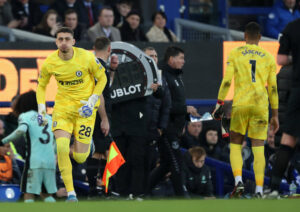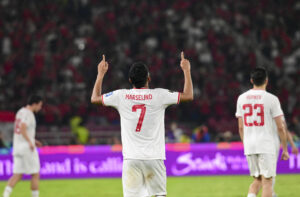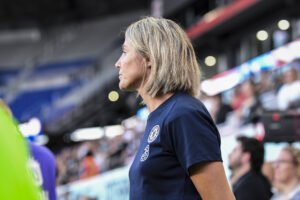Crystal Palace were a side flowing with confidence on June 20th. The Eagles had just beaten Bournemouth comfortably 2-0 in their first game of the Premier League restart. Suddenly, the prospect of a late rush into the European places seemed a distinct possibility.
Yet, fast forward a month and, following seven losses in seven successive Premier League fixtures, European dreams were quickly shattered.
Despite some tough fixtures in the season’s run-in, the dire form of Crystal Palace has highlighted the long-term identity crisis of the club.
Since gaining promotion to the Premier League in 2013, the struggle to impose a distinct plan and philosophy for the future of the club has become clear.
Crystal Palace: A Team Suffering an Identity Crisis
Lack of Attacking Quality at Crystal Palace
One of the most striking problems Palace continue to struggle with is the lack of a goal-scorer.
Christian Benteke‘s return of 17 goals in the 2016/17 season is the best return of any striker at the club since they were in the Championship. Since his first season, the Belgian striker scored six goals in 75 subsequent appearances.
No other Palace striker reached double figures in the past seven seasons. Wilfried Zaha is the leading goal-scorer for Palace over the past six campaigns. Following his return from Manchester United, the Ivorian has scored 36 Premier League goals for the club.
In the past, Palace boasted strikers who would reach double-figure goal tallies on a regular basis. But the likes of Ian Wright, Mark Bright, Chris Armstrong, Clinton Morrison, Andy Johnson and Glenn Murray seem a distant memory. No centre-forward took the mantle from Murray, who scored 30 goals in Palace’s promotion campaign.
The players to compliment Zaha’s talent are also severely lacking. Yannick Bolasie was the perfect wing partner for Zaha. Their unpredictability, directness and creativity, symbolic of what Palace was.
Whilst manager, South London-born Alan Pardew warned of losing the identity of players like Bolasie and Zaha for Palace.
In 2015, Pardew said: “The players that we produce here, they always have that type of ability where they’ll go past someone, like a street football skill.
“It’s kind of learnt on the streets of South London and that’s something we must never lose.
“[Playing for Palace] is not just about [making] a living, a profession and winning, it’s also about entertainment.”
It appears the entertainment has dried up under Roy Hodgson. Palace are the second-lowest scorers in the Premier League with 30 goals. They also scored just 14 at Selhurst Park all season, the lowest home goals in the division.
Reliance on Older Players
Palace currently fields the oldest average aged squad in the Premier League (29). This is symbolic of the policy the club have taken in recent years – to bring in tried and tested players.
The likes of Gary Cahill (34), Vicente Guaita (33), James McCarthy (29), Cheikhou Kouyaté (30) and Jordan Ayew (28) all signed over the past two seasons. Max Meyer is the only player under 25 who signed for Palace in the same time period, but the German has only made 20 starts for the club over the past two seasons.
The approach has paid off and provided stability and structure in the Premier League, but an ageing squad is only sustainable as a short-term solution. Cracks have started to appear and the fixture build-up since the restart is telling, with seven losses in a row.
Signing 19-year-old Nathan Ferguson this week will lower the average age of the squad. More signings like Fergusson will be key to a much-needed re-build at the club in the coming years.
Unwillingness to Use Youth Prospects
Palace used to have an identity of breeding promising talents from South London. As well as Wilfried Zaha, the Eagles produced Aaron Wan-Bissaka, Victor Moses, Nathaniel Clyne, Ben Watson, Wayne Routledge, Clinton Morrison, Hayden Mullins and England manager Gareth Southgate, all of whom went on to forge successful Premier League careers.
Over the past seven seasons, however, Palace have given minutes to only seven academy players. Between them, their appearances amount to 23 (12 of which were made by Jonny Williams.)
Only 20-year-old left-back Tyrick Mithcell started for Palace in the league this season, but his first professional start was more of a necessity for Roy Hodgson following Patrick van Aanholt’s injury.
This unwillingness to give younger prospects game time is the vent of ongoing frustration from the fans towards Hodgson. The likes of Brandon Pierrick, Sam Woods and Mitchell continued to watch from the sidelines despite much of the first team showing fatigue from the fixture pile-up.
Crystal Palace’s new academy building could represent a turning point for the club. The complex received category one status from the Premier League for next season. Therefore, the youth teams will play at a higher standard, such as the Premier League 2.
The long-term aim goal of the new academy setup is to attract south London’s top talent and develop them into Premier League players. It’s a big investment, but one which requires younger players more than cameo appearances or last resort starts in the first team.
Main Photo






